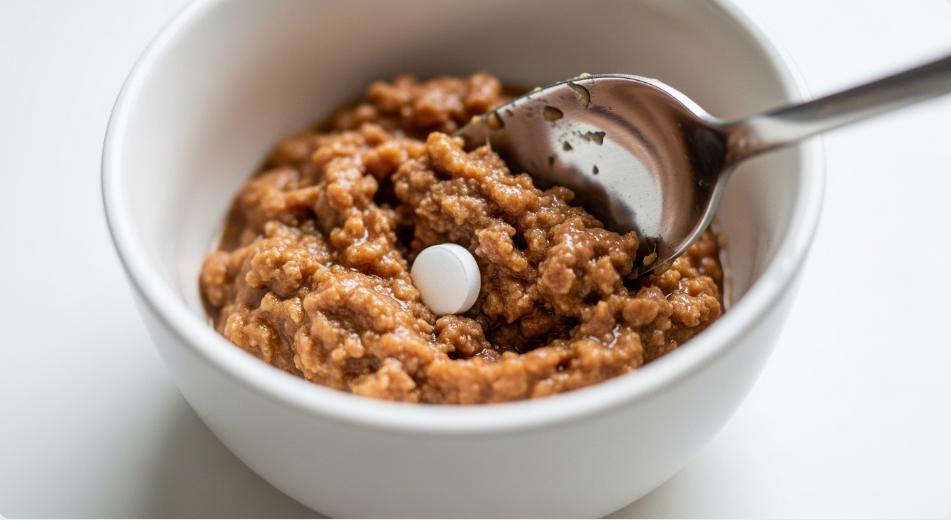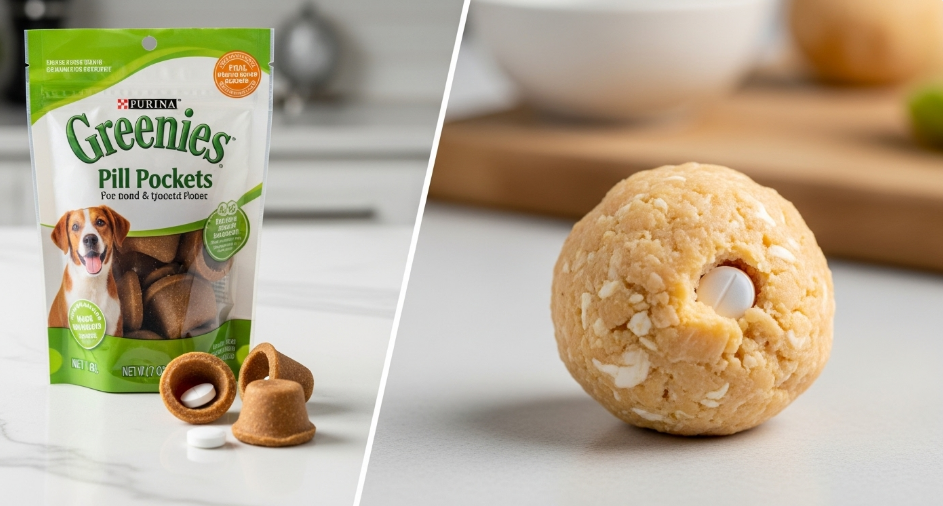Giving your cat medication doesn’t have to be a battle. Most cat parents struggle with this task, but the right approach makes it much easier for both you and your pet.
This guide covers seven proven methods veterinarians recommend. You’ll learn which technique works best for your cat’s personality and situation.
Why Giving Cats Pills Can Be Challenging
Cats have natural instincts that make medication difficult. They’re suspicious of new tastes and smells. Their sensitive noses detect medicine quickly. Plus, many cats simply don’t like being handled.
Understanding these challenges helps you choose the right method. Some cats respond well to food tricks. Others need direct administration. The key is finding what works for your specific cat.
Method 1: Hide the Pill in Food (Easiest for Most Cats)
The easiest way to give your cat a pill is to hide it in food, which works best when mixed with small amounts of tuna, salmon, wet food, or soft treats.
Best Foods for Hiding Pills:
- Wet cat food (pâté texture works best)
- Tuna or salmon (small amount)
- Plain cooked chicken
- Cat-safe baby food (no onion or garlic)
- Cream cheese or plain yogurt
Step-by-Step Process:
- Use only a small amount of food your cat will finish completely
- Make sure the pill is fully covered
- Give the medicated food first, before regular meals
- Watch to ensure your cat swallows everything
- Check that no pill pieces remain

Pro Tips:
- Test with a treat first to see if your cat notices
- Never use large portions – cats may not finish all the food
- Some medications cannot be crushed – check with your vet first
Method 2: Use Pill Pockets and Treats
Commercial pill pockets work well when you give a few plain treats first, then the pill-containing one, so your cat doesn’t become suspicious.
Commercial Options:
- Greenies Pill Pockets (chicken or salmon flavor)
- Pet-safe pill wraps
- Soft cat treats that can be molded
DIY Pill Pocket Alternative:
- Take a small piece of cooked chicken
- Make a small pocket or indent
- Place the pill inside
- Seal the opening completely
- Give immediately as a special treat

Method 3: The Three-Treat Trick
This method involves giving two plain treats followed by one containing the pill, which makes cats less suspicious of medicated treats in the future.
How It Works:
- Prepare three identical-looking treats
- Hide the pill in the middle treat only
- Give the first plain treat
- Immediately give the medicated treat
- Follow with the third plain treat
This technique works because cats get excited about the treat sequence. They’re less likely to detect the medication when they’re anticipating the next treat.
Method 4: Direct Mouth Administration
When food methods fail, direct administration becomes necessary. This requires patience and proper technique.
What You’ll Need:
- The prescribed pill
- Small amount of butter or tuna juice (to lubricate)
- Towel for wrapping (if needed)
- Assistant (helpful but not required)
Step-by-Step Process:
Hold the pill between your thumb and index finger, grasp your cat’s head from above, tilt the head back so the nose points to the ceiling, and place the pill as far back on the tongue as possible.
- Prepare the pill: Lubricate it slightly with tuna juice or butter
- Position your cat: Sit with cat in your lap or on a secure surface
- Hold the head: Place thumb on one side of upper jaw, fingers on other
- Tilt back: Nose should point toward ceiling
- Open mouth: Use your ring finger to gently press down on lower jaw
- Place pill: Drop it on the back third of the tongue
- Close mouth: Hold closed and return head to normal position
- Encourage swallowing: Gently rub the throat or blow softly on the nose
Signs Your Cat Swallowed:
Usually, a cat will lick its nose with its tongue if it has swallowed the pill.
- Licking the nose or lips
- Natural swallowing motion
- No pill visible in mouth
Method 5: Using a Pet Piller Device
A pet piller (also called a pill popper) is a small plastic tube with a plunger that gently dispenses pills into your cat’s mouth.
Advantages:
- Keeps fingers away from teeth
- Places pill precisely at back of tongue
- Reduces stress for both cat and owner
- Available at most pet stores
How to Use:
- Load the pill into the device
- Hold your cat securely
- Insert the tip into the corner of the mouth
- Push gently until mouth opens
- Advance to back of tongue
- Press plunger to release pill
- Remove device and encourage swallowing
Method 6: Towel Wrapping (Burrito Method)
Burrito-wrapping involves wrapping your cat in a towel with only the head exposed, which helps anxious or active cats feel more secure.
When to Use This Method:
- Your cat scratches or struggles
- Previous attempts resulted in stress
- Cat tries to escape during medication
Wrapping Steps:
- Lay towel flat on surface
- Place cat in center, facing away from you
- Encourage cat to lie down with legs tucked
- Wrap one corner around back and tuck near back leg
- Wrap other corner completely under cat’s body
- Only head should remain exposed
- Ensure wrap is snug but not tight
Method 7: Liquid or Compounded Alternatives
If traditional pills don’t work, veterinary pharmacies can prepare many medications into flavored liquids or even gels that can be applied to the ear flap.
Available Alternatives:
- Flavored liquid medications (tuna, chicken, salmon)
- Transdermal gels (applied to inner ear)
- Injectable forms (given by veterinarian)
- Flavored chewable tablets
Benefits:
- Easier for cats who hate pills
- Better absorption in some cases
- Reduces stress for both pet and owner
- Often more palatable
Contact your veterinarian to discuss these options. Many medications can be compounded into more manageable forms.
Safety Tips and Important Warnings
Before You Start:
- Read prescription labels carefully
- Understand dosing instructions completely
- Never interrupt eating, grooming, or litter box use
- Stay calm – cats sense your stress
Watch for These Warning Signs:
Signs your cat needs a break include growling, hissing, ears flat against head, wide pupils, tail swishing, rigid posture, or fur standing up.
After Giving Medication:
- Offer fresh water
- Provide positive reinforcement (treats, petting, play)
- Monitor for side effects
- Ensure pill was swallowed completely
What to Do When Methods Don’t Work
If Your Cat Refuses All Methods:
- Contact your veterinarian immediately
- Ask about alternative medication forms
- Request a demonstration of techniques
- Consider professional administration
Never Do These Things:
- Force open the mouth with your hands
- Crush pills without vet approval
- Punish your cat for resistance
- Mix medication with full meals
- Give up on prescribed treatment
Frequently Asked Questions
How do you give an unwilling cat a pill?
Start with food methods first. If those fail, use towel wrapping with direct administration or a pet piller device. Consider asking your vet about liquid alternatives.
Can I crush my cat’s pills?
Only if your veterinarian specifically says it’s safe. Some medications lose effectiveness when crushed or can become harmful.
How long should I wait between attempts?
Give your cat at least 30 minutes to calm down between attempts. Never force multiple tries in quick succession.
What if my cat foams at the mouth?
Some cats produce excess saliva when stressed or if they taste something bitter. This is usually normal, but contact your vet if it continues or worsens.
How do I know if the pill was swallowed?
Watch for nose licking, natural swallowing motions, and absence of the pill in the mouth. You can offer a small amount of water to help wash it down.
Making Future Medication Easier
Build Positive Associations:
- Practice handling paws and mouth during healthy times
- Reward cooperation with high-value treats
- Keep medication sessions short and positive
- Maintain consistent, gentle handling
Preparation Tips:
- Have all supplies ready beforehand
- Choose quiet times when your cat is relaxed
- Consider timing around meals (check with vet first)
- Ask family members to help if needed
When to Contact Your Veterinarian
Call your vet if:
- Your cat hasn’t eaten the medicated food within 2 hours
- Multiple attempts result in extreme stress
- You’re unsure about proper dosing
- Side effects occur after medication
- Your cat completely refuses all methods
Remember, your veterinarian wants your cat’s treatment to succeed. They can provide additional techniques or alternative medications to make the process easier.
Understanding why cats knead can help you recognize when your cat is relaxed and ready for medication. Similarly, learning about what catnip does to cats might help you use it as a calming aid before medication time.
Conclusion
Giving your cat medication doesn’t have to be traumatic. Start with the easiest food-based methods first. If those don’t work, progress to direct administration techniques.
Every cat is different. What works for one may not work for another. Be patient, stay calm, and don’t hesitate to ask your veterinarian for help.
With practice and the right technique, medication time can become a manageable part of your cat’s healthcare routine.
